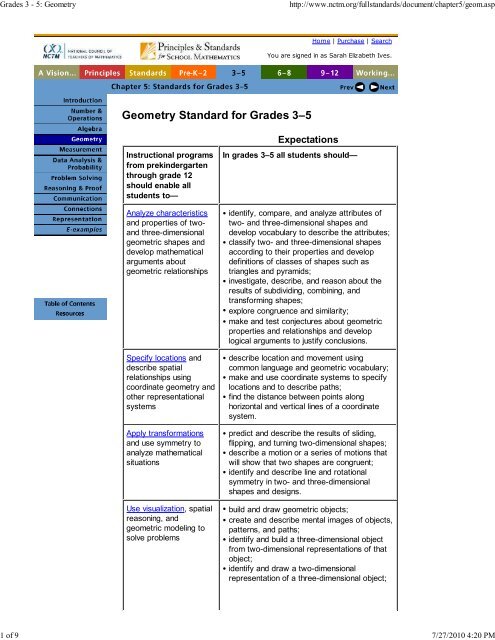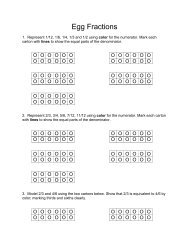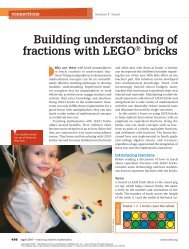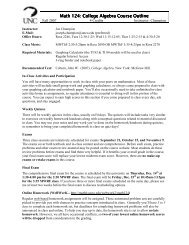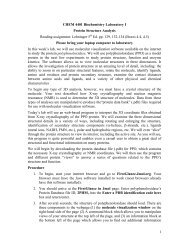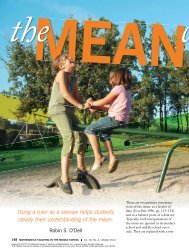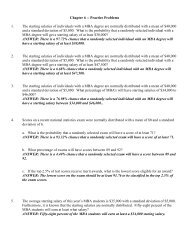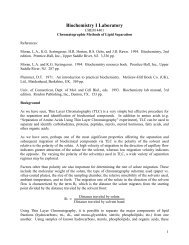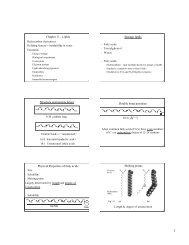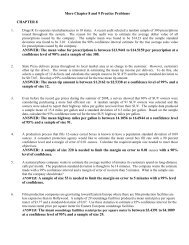Geometry Standard for Grades 3–5
Geometry Standard for Grades 3–5
Geometry Standard for Grades 3–5
You also want an ePaper? Increase the reach of your titles
YUMPU automatically turns print PDFs into web optimized ePapers that Google loves.
<strong>Grades</strong> 3 - 5: <strong>Geometry</strong>http://www.nctm.org/fullstandards/document/chapter5/geom.asp1 of 9 7/27/2010 4:20 PMHome | Purchase | SearchYou are signed in as Sarah Elizabeth Ives.<strong>Geometry</strong> <strong>Standard</strong> <strong>for</strong> <strong>Grades</strong> 3–5Instructional programsfrom prekindergartenthrough grade 12should enable allstudents to—Analyze characteristicsand properties of twoandthree-dimensionalgeometric shapes anddevelop mathematicalarguments aboutgeometric relationshipsSpecify locations anddescribe spatialrelationships usingcoordinate geometry andother representationalsystemsApply trans<strong>for</strong>mationsand use symmetry toanalyze mathematicalsituationsUse visualization, spatialreasoning, andgeometric modeling tosolve problemsExpectationsIn grades 3–5 all students should—• identify, compare, and analyze attributes oftwo- and three-dimensional shapes anddevelop vocabulary to describe the attributes;• classify two- and three-dimensional shapesaccording to their properties and developdefinitions of classes of shapes such astriangles and pyramids;• investigate, describe, and reason about theresults of subdividing, combining, andtrans<strong>for</strong>ming shapes;• explore congruence and similarity;• make and test conjectures about geometricproperties and relationships and developlogical arguments to justify conclusions.• describe location and movement usingcommon language and geometric vocabulary;• make and use coordinate systems to specifylocations and to describe paths;• find the distance between points alonghorizontal and vertical lines of a coordinatesystem.• predict and describe the results of sliding,flipping, and turning two-dimensional shapes;• describe a motion or a series of motions thatwill show that two shapes are congruent;• identify and describe line and rotationalsymmetry in two- and three-dimensionalshapes and designs.• build and draw geometric objects;• create and describe mental images of objects,patterns, and paths;• identify and build a three-dimensional objectfrom two-dimensional representations of thatobject;• identify and draw a two-dimensionalrepresentation of a three-dimensional object;
<strong>Grades</strong> 3 - 5: <strong>Geometry</strong>http://www.nctm.org/fullstandards/document/chapter5/geom.asp2 of 9 7/27/2010 4:20 PM• use geometric models to solve problems inother areas of mathematics, such as numberand measurement;• recognize geometric ideas and relationshipsand apply them to other disciplines and toproblems that arise in the classroom or ineveryday life.The reasoning skills that students develop in grades 3–5 allowthem to investigate geometric problems of increasingcomplexity and to study geometric properties. As they movefrom grade 3 to grade 5, they should develop clarity andprecision in describing the properties of geometric objects andthen classifying them by these properties into categories suchas rectangle, triangle, pyramid, or prism. They can developknowledge about how geometric shapes are related to oneanother and begin to articulate geometric arguments about theproperties of these shapes. They should also explore motion,location, and orientation by, <strong>for</strong> example, creating paths on acoordinate grid or defining a series of flips and turns todemonstrate that two shapes are congruent. As studentsinvestigate geometric properties and relationships, their workcan be closely connected with other mathematical topics,especially measurement and number.The study of geometry in grades 3–5 requires thinking anddoing. As students sort, build, draw, model, trace, measure,and construct, their capacity to visualize geometricrelationships will develop. At the same time they are learning toreason and to make, test, and justify conjectures about theserelationships. This exploration requires access to a variety oftools, such as graph paper, rulers, pattern blocks, geoboards,and geometric solids, and is greatly enhanced by electronictools that support exploration, such as dynamic geometrysoftware.Analyze characteristics and properties of two- and threedimensionalgeometric shapes and develop mathematicalarguments about geometric relationshipsIn the early grades, students will have classified and sortedgeometric objects such as triangles or cylinders by notinggeneral characteristics. In grades 3–5, they should developmore-precise ways to describe shapes, focusing on identifyingand describing the shape's properties and learning specializedvocabulary associated with these shapes and properties. Toconsolidate their ideas, students should draw and constructshapes, compare and discuss their attributes, classify them,and develop and consider definitions on the basis of a shape's
<strong>Grades</strong> 3 - 5: <strong>Geometry</strong>http://www.nctm.org/fullstandards/document/chapter5/geom.asp3 of 9 7/27/2010 4:20 PMproperties, such as that a rectangle has four straight sides andfour square corners. For example, many students in thesegrades will easily name the first two shapes in figure 5.10 asrectangles but will need to spend more time discussing why thethird one is also a rectangle—indeed, a special kind ofrectangle.Fig. 5.10. Examples of rectanglesp. 165 In grades 3–5, teachers should emphasize the development ofmathematical arguments. As students' ideas about shapesevolve, they should » <strong>for</strong>mulate conjectures about geometricproperties and relationships. Using drawings, concretematerials, and geometry software to develop and test theirideas, they can articulate clear mathematical arguments aboutwhy geometric relationships are true. For example: "You can'tpossibly make a triangle with two right angles because if youstart with one side of the triangle across the bottom, the othertwo sides go straight up. They're parallel, so they can't possiblyever meet, so you can't get it to be a triangle."When students subdivide, combine, and trans<strong>for</strong>m shapes,they are investigating relationships among shapes. Forexample, a fourth-grade class might investigate the relationshipbetween a rectangle and a nonrectangular parallelogram withequal bases and heights (see fig. 5.11) by asking, "Does one ofthese shapes have a larger area than the other?" One studentmight cut the region <strong>for</strong>med by the parallelogram as shown infigure 5.11 and then rearrange the pieces so that theparallelogram visually matches the rectangle. This work canlead to developing a general conjecture about the relationshipbetween the areas of rectangles and parallelograms with thesame base and height. The notion that shapes that lookdifferent can have equal areas is a powerful one that leadseventually to the development of general methods (<strong>for</strong>mulas)<strong>for</strong> finding the area of a particular shape, such as aparallelogram. In this investigation, students are building theirideas about the properties of classes of shapes, <strong>for</strong>mulatingconjectures about geometric relationships, exploring howgeometry and measurement are related, and investigating theshapes with equal area.
<strong>Grades</strong> 3 - 5: <strong>Geometry</strong>http://www.nctm.org/fullstandards/document/chapter5/geom.asp4 of 9 7/27/2010 4:20 PMFig. 5.11. The relationship between the areas of a rectangle and anonrectangular parallelogram with equal bases and heightsAn understanding of congruence and similarity will develop asstudents explore shapes that in some way look alike. Theyshould come to understand congruent shapes as those thatexactly match and similar shapes as those that are related by"magnifying" or "shrinking." For example, consider the followingproblem involving the creation of shapes with a particular set ofproperties:Make a triangle with one right angle and two sides of equallength. Can you make more than one triangle with this set ofproperties? If so, what is the relationship of the triangles to oneanother?As students make triangles with the stipulated properties (seefig. 5.12), they will see that although these triangles share acommon set of characteristics (one right angle and a pair ofsides of equal length), they are not all the same size. However,they are all related in that they look alike; that is, one is just asmaller or larger version of the other. The triangles are similar.Although students will not develop a full understanding ofsimilarity until the middle grades, when they focus onproportionality, in grades 3–5 they can begin to think aboutsimilarity in terms of figures that are related by thetrans<strong>for</strong>mations of magnifying or shrinking.Fig. 5.12. Right triangles with two sides of equal lengthp. 166When discussing shapes, students in grades 3–5 should beexpanding their mathematical vocabulary by hearing termsused repeatedly in context. As they describe shapes, theyshould hear, understand, and use mathematical terms such asparallel, perpendicular, face, edge, vertex, angle, trapezoid,prism, and so <strong>for</strong>th, to communicate geometric ideas withgreater precision. For example, as students develop a moresophisticated understanding of how geometric shapes can bethe same or different, the everyday meaning of same is no
<strong>Grades</strong> 3 - 5: <strong>Geometry</strong>http://www.nctm.org/fullstandards/document/chapter5/geom.asp5 of 9 7/27/2010 4:20 PMlonger sufficient, and they begin to need words such ascongruent and similar to explain their thinking. »Specify locations and describe spatial relationships usingcoordinate geometry and other representational systemsIn grades 3–5, the ideas about location, direction, and distancethat were introduced in prekindergarten through grade 2 canbe developed further. For instance, students can givedirections <strong>for</strong> moving from one location to another in theirclassroom, school, or neighborhood; use maps and grids; andlearn to locate points, create paths, and measure distanceswithin a coordinate system. Students can first navigate on gridsby using landmarks. For example, the map in figure 5.13 canbe used to explore questions like these: What is the shortestpossible route from the school to the park along the streets(horizontal and vertical lines of the grid)? How do you know?Can there be several different "shortest paths," each of which isequal in length? If so, how many different "shortest paths" arethere? What if you need to start at the school, go to the park topick up your little sister, stop at the store, and visit thelibrary—in what order should you visit these locations tominimize the distance traveled? In this activity, students areusing grids and developing fundamental ideas and strategies<strong>for</strong> navigating them, an important component of discretemathematics.Fig. 5.13. A map <strong>for</strong> exploring questions about navigationStudents at this level also should learn how to use twonumbers to name points on a coordinate grid and shouldrealize that a pair of numbers corresponds to a particular pointon the grid. Using coordinates, they can specify paths betweenlocations and examine the symmetry, congruence, andsimilarity of shapes drawn on the grid. They can also exploremethods <strong>for</strong> measuring the distance between locations on thegrid. As students' ideas about the number system expand toinclude negative numbers, they can work in all four quadrants
<strong>Grades</strong> 3 - 5: <strong>Geometry</strong>http://www.nctm.org/fullstandards/document/chapter5/geom.asp6 of 9 7/27/2010 4:20 PMof the Cartesian plane.Apply trans<strong>for</strong>mations and use symmetry to analyzemathematical situationsp. 167 Students in grades 3–5 should consider three important kindsof trans<strong>for</strong>mations: reflections, translations, and rotations (flips,slides, and turns). Younger students generally "prove"(convince themselves) that two shapes are congruent byphysically fitting one on top of the other, but students in grades3–5 can develop greater precision as they describe the motionsneeded to show congruence ("turn it 90°" or "flip it vertically,then rotate it 180°"). They should also be able to visualize »what will happen when a shape is rotated or reflected andpredict the result.Students in grades 3–5 can explore shapes with more than oneline of symmetry. For example:In how many ways can you place a mirror on a square so thatwhat you see in the mirror looks exactly like the original square?Is this true <strong>for</strong> all squares?Can you make a quadrilateral with exactly two lines ofsymmetry? One line of symmetry? No lines of symmetry? If so,in each case, what kind of quadrilateral is it?Although younger students often create figures with rotationalsymmetry with, <strong>for</strong> example, pattern blocks, they have difficultydescribing the regularity they see. In grades 3–5, they shouldbe using language about turns and angles to describe designssuch as the one in figure 5.14: "If you turn it 180 degrees aboutthe center, it's exactly the same" or "It would take six equalsmall turns to get back to where you started, but you can't tellwhere you started unless you mark it because it looks the sameafter each small turn."
<strong>Grades</strong> 3 - 5: <strong>Geometry</strong>http://www.nctm.org/fullstandards/document/chapter5/geom.asp7 of 9 7/27/2010 4:20 PMFig. 5.14. Pattern with rotational symmetryUse visualization, spatial reasoning, and geometricmodeling to solve problemsStudents in grades 3–5 should examine the properties oftwo-and three-dimensional shapes and the relationshipsamong shapes. They should be encouraged to reason aboutthese properties by using spatial relationships. For instance,they might reason about the area of a triangle by visualizing itsrelationship to a corresponding rectangle or othercorresponding parallelogram. In addition to studying physicalmodels of these geometric shapes, they should also developand use mental images. Students at this age are ready tomentally manipulate shapes, and they can benefit fromexperiences that challenge them and that can also be verifiedphysically. For example, "Draw a star in the upper right-handcorner of a piece of paper. If you flip the paper horizontally andthen turn it 180°, where will the star be?"p. 168 Much of the work students do with three-dimensional shapesinvolves visualization. By representing three-dimensionalshapes in two dimensions and constructing three-dimensionalshapes from two-dimensional » representations, students learnabout the characteristics of shapes. For example, in order todetermine if the two-dimensional shape in figure 5.15 is a netthat can be folded into a cube, students need to pay attentionto the number, shape, and relative positions of its faces.Fig. 5.15. A task relating a two-dimensional shape to a threedimensionalshapeStudents should become experienced in using a variety ofrepresentations <strong>for</strong> three-dimensional shapes, <strong>for</strong> example,making a freehand drawing of a cylinder or cone orconstructing a building out of cubes from a set of views (i.e.,front, top, and side) like those shown in figure 5.16.
<strong>Grades</strong> 3 - 5: <strong>Geometry</strong>http://www.nctm.org/fullstandards/document/chapter5/geom.asp8 of 9 7/27/2010 4:20 PMFig. 5.16. Views of a three-dimensional object (Adapted fromBattista and Clements 1995, p. 61)ExploringRectangles andParallelogramsTechnology af<strong>for</strong>ds additional opportunities <strong>for</strong> students toexpand their spatial reasoning ability. Software such as Logoenables students to draw objects with specified attributes andto test and modify the results. Computer games such as Tetris(Pajitnov 1996) can help develop spatial orientation andeye-hand coordination. Dynamic geometry software provides anenvironment in which students can explore relationships andmake and test conjectures.Students should have the opportunity to apply geometric ideasand relationships to other areas of mathematics, to otherdisciplines, and to problems that arise from their everydayexperiences. There are many ways to make these connections.For example, measurement and geometry are closely linked, asillustrated in the problem in figure 5.11, where geometricproperties are used to relate the areas of two figures of differentshapes. Geometric models are also important in investigatingnumber relationships. Number lines, arrays, and manymanipulatives used <strong>for</strong> modeling number concepts aregeometric realizations of arithmetic relationships. In algebra,students in grades 3–5 often work with geometric problems toexplore patterns and functions (see, <strong>for</strong> example, the "tower ofcubes" problem in fig. 5.5).In addition to its utility in exploring and understanding otherareas of mathematics, geometry is closely associated with othersubjects, such as art, science, and social studies. For example,students' work on symmetry can enhance their creation andappreciation of art, and their work on coordinate geometry isrelated to the maps they create or use in their study of theworld. The study of geometry promotes a deeperunderstanding of many aspects of mathematics, improvesstudents' abstract reasoning, and highlights relationshipsbetween mathematics and the sciences.
<strong>Grades</strong> 3 - 5: <strong>Geometry</strong>http://www.nctm.org/fullstandards/document/chapter5/geom.asp9 of 9 7/27/2010 4:20 PMHome | Table of Contents | Purchase | ResourcesNCTM HomeCopyright © 2000-2004 by the National Council of Teachers of Mathematics. Terms of Use.


